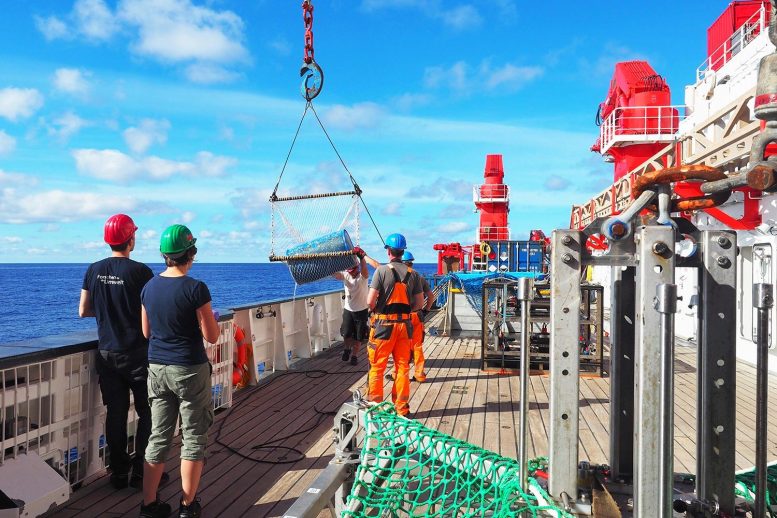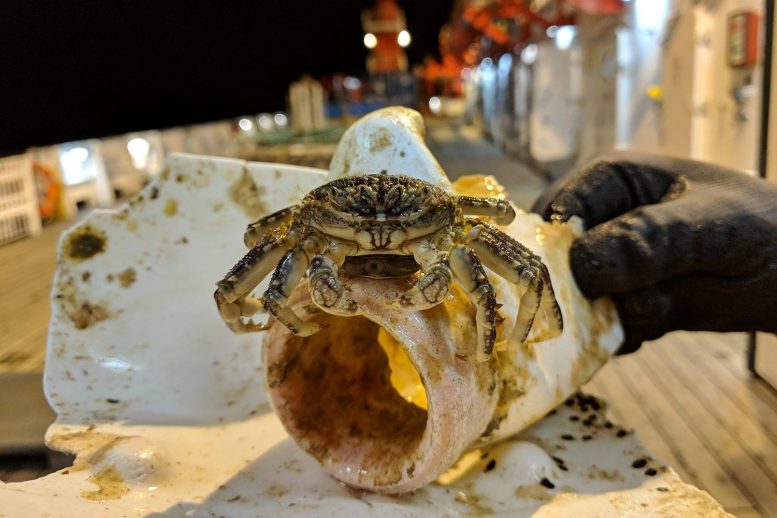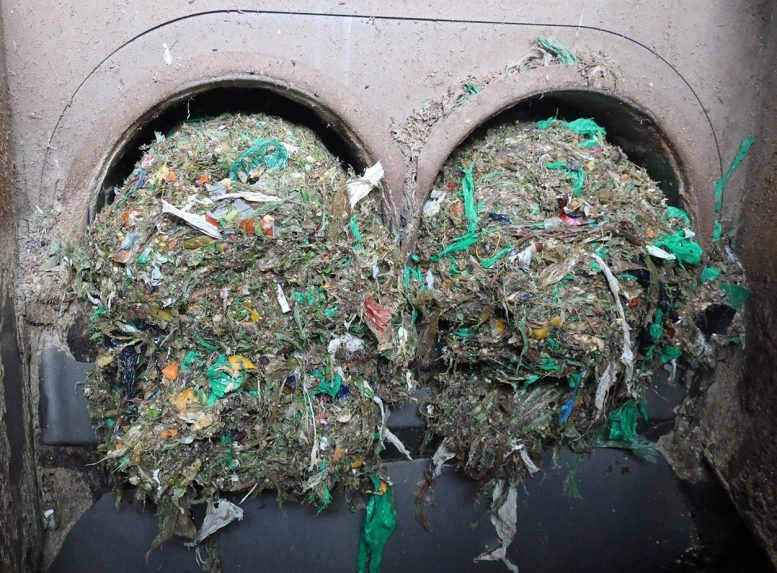
Catching a big blue barrel floating on the ocean surface in the Great Pacific Garbage Patch from the German research vessel SONNE during expedition SO268/3 crossing the North Pacific Ocean from Vancouver to Singapore in summer, 2019. Credit: ©Roman Kroke UFZ
Current rates of plastic emissions globally may trigger effects that we will not be able to reverse, argues a new study by researchers from Sweden, Norway and Germany published on July 2nd in Science. According to the authors, plastic pollution is a global threat, and actions to drastically reduce emissions of plastic to the environment are “the rational policy response.”
Plastic is found everywhere on the planet: from deserts and mountaintops to deep oceans and Arctic snow. As of 2016, estimates of global emissions of plastic to the world’s lakes, rivers, and oceans ranged from 9 to 23 million metric tons per year, with a similar amount emitted onto land yearly. These estimates are expected to almost double by 2025 if business-as-usual scenarios apply.
“Plastic is deeply engrained in our society, and it leaks out into the environment everywhere, even in countries with good waste-handling infrastructure,” says Matthew MacLeod, Professor at Stockholm University and lead author of the study. He says that emissions are trending upward even though awareness about plastic pollution among scientists and the public has increased significantly in recent years.
That discrepancy is not surprising to Mine Tekman, a PhD candidate at the Alfred Wegener Institute in Germany and co-author of the study, because plastic pollution is not just an environmental issue but also a “political and economic” one. She believes that the solutions currently on offer, such as recycling and cleanup technologies, are not sufficient, and that we must tackle the problem at its root.

Surface-floating macroplastic item with a decapod, sampled from the German research vessel SONNE during expedition SO268/3 crossing the North Pacific Ocean from Vancouver to Singapore in summer, 2019. Credit: ©Gritta Veit-Köhler Senckenberg
“The world promotes technological solutions for recycling and to remove plastic from the environment. As consumers, we believe that when we properly separate our plastic trash, all of it will magically be recycled. Technologically, recycling plastic has many limitations, and countries that have good infrastructures have been exporting their plastic waste to countries with worse facilities. Reducing emissions requires drastic actions, like capping the production of virgin plastic to increase the value of recycled plastic, and banning export of plastic waste unless it is to a country with better recycling” says Tekman.
A poorly reversible pollutant of remote areas of the environment
Plastic accumulates in the environment when amounts emitted exceed those that are removed by cleanup initiatives and natural environmental processes, which occurs by a multi-step process known as weathering.
“Weathering of plastic happens because of many different processes, and we have come a long way in understanding them. But weathering is constantly changing the properties of plastic pollution, which opens new doors to more questions,” says Hans Peter Arp, a researcher at the Norwegian Geotechnical Institute (NGI) and Professor at the Norwegian University of Science and Technology (NTNU) who has also co-authored the study. “Degradation is very slow and not effective in stopping accumulation, so exposure to weathered plastic will only increase,” says Arp. Plastic is, therefore, a “poorly reversible pollutant”, both because of its continuous emissions and environmental persistence.

Plastic residue being filtered out of food waste collected in Norway after fermentation to biogas and soil fertilizer. Credit: Caroline Hansen and Heidi Knutsen, NGI
Remote environments are particularly under threat as co-author Annika Jahnke, a researcher at the Helmholtz Centre for Environmental Research (UFZ) and Professor at the RWTH Aachen University explains:
“In remote environments, plastic debris cannot be removed by cleanups, and weathering of large plastic items will inevitably result in the generation of large numbers of micro- and nanoplastic particles as well as leaching of chemicals that were intentionally added to the plastic and other chemicals that break off the plastic polymer backbone. So, plastic in the environment is a constantly moving target of increasing complexity and mobility. Where it accumulates and what effects it may cause are challenging or maybe even impossible to predict.”
A potential tipping point of irreversible environmental damage
On top of the environmental damage that plastic pollution can cause on its own by entanglement of animals and toxic effects, it could also act in conjunction with other environmental stressors in remote areas to trigger wide-ranging or even global effects. The new study lays out a number of hypothetical examples of possible effects, including exacerbation of climate change because of disruption of the global carbon pump, and biodiversity loss in the ocean where plastic pollution acts as additional stressor to overfishing, ongoing habitat loss caused by changes in water temperatures, nutrient supply and chemical exposure.
Taken all together, the authors view the threat that plastic being emitted today may trigger global-scale, poorly reversible impacts in the future as a “compelling motivation” for tailored actions to strongly reduce emissions.
“Right now, we are loading up the environment with increasing amounts of poorly reversible plastic pollution. So far, we don’t see widespread evidence of bad consequences, but if weathering plastic triggers a really bad effect we are not likely to be able to reverse it,” cautions MacLeod. “The cost of ignoring the accumulation of persistent plastic pollution in the environment could be enormous. The rational thing to do is to act as quickly as we can to reduce emissions of plastic to the environment.”
Reference: “The global threat from plastic pollution” by Matthew MacLeod, Hans Peter H. Arp, Mine B. Tekman and Annika Jahnke, 2 July 2021, Science.
DOI: 10.1126/science.abg5433









I agree that plastic pollution has undesirable effects on the environment and is certainly not aesthetic! However, saying that it is possibly yet another “tipping point” is over the top. There was no good evidence given for it either being irreversible or having existential consequences. It is conjecture without supporting facts.
More importantly, the Captain Obvious solution of reducing emissions is simplistic. What is missing is how the reduction can be accomplished economically and effectively, especially when the major source of ocean pollution appears to be coming from Asia where the cultures don’t recognize individual responsibility for pollution. What is also missing from the article is any suggestion on how something else, less damaging, might be substituted for plastics.
“especially when the major source of ocean pollution appears to be coming from Asia where the cultures don’t recognize individual responsibility for pollution.”
I agree with what you said, but I would like to add that “the west” was responsible for a good part of this issue when corporations lobbied politicians and regulatory institutions which allowed millions of plastic to be shipped in containers to asian countries, “supposedly” to recycle it.
Recycling was (still is) one of the biggest scams in history, and I’m not just speaking about plastic. Go and search on the topic and watch some documentaries… get familiarized with the concept of “greenwashing”.
The process to solve this issue is not hard, not at all, it only requires international agreement and an agenda with goalposts that don’t get delayed or altered.
I can confidently say that it’s possible to cut plastic consumption and thus production
in at least in half and in less than a decade without making drastic lifestyle changes.
For once, taxes and outright banning appears to be the solution.
For the most part, single use plastics can easily disappear, be reduced and replaced by a biodegradable plastic polymer or a material that fulfills the same function, like paper, metal alloys, glass…
Promote reusability and quality of products with extended lifetime instead of the Chinese philosophy of mass production of cheap, low quality products…
Clothing fibers made of polyester also produce tons of micro plastic fibers, promote biodegradable options like cotton, linen…
Invest in better waste management systems, invest in new tech research…
Apply the existent laws!!
Apply fines for companies and individuals who often dispose toxic waste to the ground and water…
…
This problem could have been tackled decades ago but politicians failed us, like they always do.
And stop the doomsday scenario advertising, a trick only works so many times… you are only really weaponizing idiots and kids who are in no position of making changes, unless you are Greta. If this is supposed to be some kind of science news website you should present hard evidence to all the statements… “May Be Nearing an Irreversible Tipping Point”…
Unlike the authors of the article, you actually offer solutions. Additionally, anoxic thermal degradation, or pyrolysis, using solar energy, can probably address the other half of the problem that your suggestions don’t.
I never meant to suggest that the problem was unsolvable. Only that hand wringing and threats of an existential ‘Tipping Point’ were not constructive nor examples of creative thinking. However, there also need to be some cultural changes with respect to disposable waste!
Gee, I have an idea. How about we go back to life before all food products were packaged in plastic? I never had a problem with meat packaged in white butcher paper, or soda in reusable glass bottles, or non-perishable food packed in metal cans and glass jars, or frozen foods packaged in aluminum trays with aluminum foil over the top.